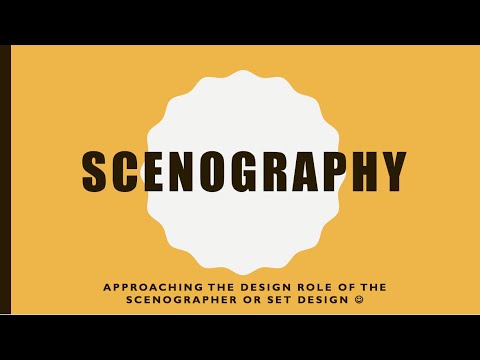Scenographer Job Description and Salary: All You Need to Know!

Scenographer Job Description Template
Scenographer Job Description A scenographer is a professional who combines the skills of a set designer, costume designer, and lighting designer to create visually captivating and immersive stage environments for theatrical productions, films, and other events. They work closely with directors, producers, and other members of the creative team to bring their artistic vision to life. The primary responsibility of a scenographer is to design and build the physical set, which includes the stage, props, and other scenic elements. They must carefully consider the script, theme, and overall concept of the production to create a cohesive and aesthetically pleasing design. This involves researching and selecting appropriate materials, colors, textures, and styles. They may also collaborate with carpenters, painters, and other technicians to construct and install the set. In addition to set design, scenographers are also responsible for designing costumes and selecting appropriate lighting and sound effects. They work closely with costume designers to create outfits that enhance the characters and overall visual appearance of the production. They also collaborate with lighting designers to ensure that the lighting enhances the mood and atmosphere of each scene. Attention to detail and strong artistic and creative skills are essential for a scenographer. They must have a deep understanding of visual composition, color theory, and design principles. They should also possess excellent communication and collaboration skills to effectively work with the creative team and bring their vision to fruition. In conclusion, a scenographer is a versatile and integral part of any production, combining various design elements to create visually stunning stage environments. Their role is crucial in bringing the director’s vision to life and creating a memorable experience for the audience.Scenographer Responsibilities
Scenographer Requirements
How Much Does A Scenographer Make?
Scenographer Salary
| Experience Level | Salary Range |
|---|---|
| Entry Level | $30,000 – $45,000 per year |
| Mid-Level | $45,000 – $65,000 per year |
| Senior Level | $65,000 – $90,000 per year |
A scenographer is responsible for designing and creating the visual elements of a theatrical production or an event. This includes sets, props, lighting, and costumes. The salary of a scenographer varies based on their experience level.
Entry level scenographers can expect to earn between $30,000 and $45,000 per year. As they gain more experience and expertise, mid-level scenographers can earn between $45,000 and $65,000 per year. Senior level scenographers, who have extensive experience and a proven track record, can earn between $65,000 and $90,000 per year.
It is important to note that these salary ranges can vary depending on factors such as location, industry, and the scale of the production or event. Additionally, freelance scenographers may earn different rates based on individual projects and negotiations.
Overall, scenography can be a rewarding career for those passionate about visual storytelling and creating immersive experiences in the performing arts industry.
Scenographer Salaries by Country
Top Paying Countries for Scenographer
| Country | Average Annual Salary (USD) |
|---|---|
| United States | 60,000 |
| Switzerland | 55,000 |
| Australia | 50,000 |
| Germany | 45,000 |
| United Kingdom | 40,000 |
Scenographers are highly valued in the United States, with an average annual salary of $60,000. Switzerland follows closely with an average salary of $55,000, while Australia offers an average of $50,000. In Germany, scenographers earn an average of $45,000, and in the United Kingdom, the average salary is $40,000. These figures reflect the demand for skilled scenographers and the importance placed on their contributions in creating captivating stage and set designs. Scenographers in these countries can expect competitive compensation for their expertise and artistic vision.
A video on the topic Scenographer
Video Source : BHDouglasInterview Questions for Scenographer
1. What is the role of a Scenographer?
A Scenographer is responsible for creating the visual elements of a theatrical production, including the set design, lighting design, and costume design.
2. What skills are important for a Scenographer to have?
A Scenographer should have strong artistic and creative abilities, as well as technical knowledge in areas such as set construction, lighting equipment, and costume design. They should also possess good communication and collaboration skills to work effectively with the production team.
3. How do you approach the design process as a Scenographer?
As a Scenographer, I start by thoroughly reading and analyzing the script to understand the story and its themes. Then, I collaborate with the director and other members of the production team to develop a concept and aesthetic vision for the production. From there, I create sketches, renderings, and models to communicate my design ideas.
4. How do you stay updated on the latest trends and techniques in scenography?
I attend industry conferences, workshops, and exhibitions to stay updated on the latest trends and techniques in scenography. I also regularly read books, articles, and online resources related to theatrical design. Additionally, I collaborate with other scenographers and attend performances to gain insights and inspiration.
5. Can you provide an example of a challenging project you have worked on as a Scenographer?
One challenging project I worked on was a production of a play set in a futuristic world. The script called for innovative and unconventional set designs, incorporating technology and interactive elements. It required extensive research and experimentation to create a visually striking and functional set that effectively conveyed the futuristic atmosphere of the play.
6. How do you collaborate with other members of the production team?
I believe in open and effective communication with other members of the production team. I actively participate in production meetings, sharing my design ideas and listening to feedback from others. I collaborate closely with the director, lighting designer, costume designer, and technical team to ensure a cohesive and successful production.
7. How do you handle challenges or changes during the production process?
I understand that challenges and changes are inevitable during the production process. I remain flexible and adaptable, finding creative solutions to overcome obstacles. I am open to feedback and willing to make adjustments to my designs if necessary to better serve the artistic vision of the production.
8. What do you consider the most important aspect of a set design?
I consider the most important aspect of a set design to be how effectively it supports and enhances the storytelling. The set should create the appropriate atmosphere, evoke emotions, and provide practical functionality for the actors and the overall production. It should be visually compelling and contribute to the overall artistic vision of the play.
9. How do you ensure the safety of the actors and crew on stage?
I prioritize the safety of the actors and crew by working closely with the technical team to ensure that all set elements are secure and stable. I adhere to safety guidelines and regulations for set construction, lighting, and special effects. I also conduct regular inspections of the set during rehearsals and performances to identify and address any potential hazards.
10. How do you handle budget constraints in your designs?
When faced with budget constraints, I focus on maximizing the impact of the design within the available resources. I prioritize essential elements and explore cost-effective alternatives without compromising the artistic vision. I collaborate with the production team to find creative solutions and make informed decisions that balance the budget with the desired aesthetic and functionality of the set design.






